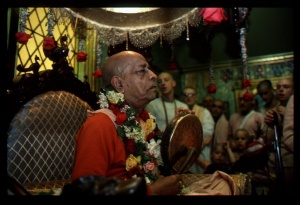CC Madhya 6.152 (1975)

A.C. Bhaktivedanta Swami Prabhupada
Below is the 1996 edition text, ready to be substituted with the 1975 one using the compile form.
TEXT 152
- ṣaḍ-aiśvarya-pūrṇānanda-vigraha yāṅhāra
- hena-bhagavāne tumi kaha nirākāra?
SYNONYMS
ṣaṭ-aiśvarya-pūrṇa—with six opulences in full; ānanda—blissful; vigraha—form; yāṅhāra—whose; hena-bhagavāne—unto that Supreme Personality of Godhead; tumi—you; kaha—said; nirākāra—without any form.
TRANSLATION
“Are you describing as formless that Supreme Personality of Godhead whose transcendental form is complete with six transcendental opulences?
PURPORT
If the Supreme Personality of Godhead is formless, how can He be said to walk very fast and accept everything offered to Him? Rejecting the direct meaning of the Vedic mantras, the Māyāvādī philosophers interpret them and try to establish the Absolute Truth as formless. Actually, the Supreme Lord has an eternal personal form full of all opulence. The Māyāvādī philosophers try to interpret the Absolute Truth as being without potency. However, in the Śvetāśvatara Upaniṣad (6.8) it is clearly said, parāsya śaktir vividhaiva śrūyate: (CC Madhya 13.65 (1975), purport) “The Absolute Truth has multipotencies.”